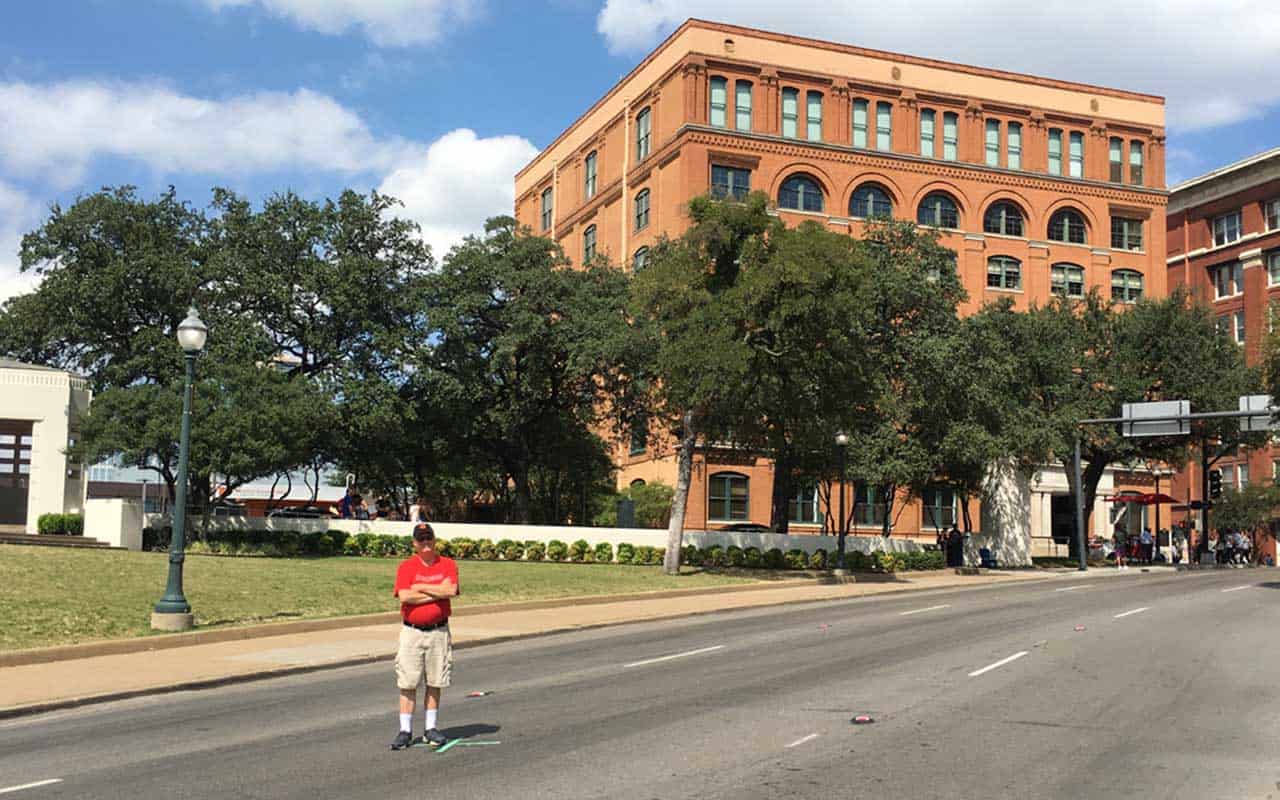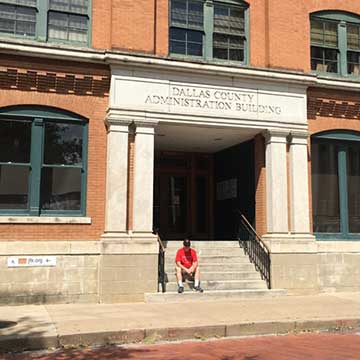This Month’s Featured Article

Finally, Dallas
 This article is a little bit … different(?) from what you might be used to, but we love history around here, so I thought this would definitely be interesting or at least a bit of a head-scratcher making you go, “Hmm?” Jesse proposed this article based on his curiosity and compilations of his experiences examining President John F. Kennedy’s assassination in Dallas, TX. The topic fascinates people from all around the world, even to this day. For Jesse, it has resulted in numerous trips to Dealey Plaza, reading countless documents, and watching just about all of the documentaries. This article features Jesse’s musings on the topic. Enjoy. –Editor’s note.
This article is a little bit … different(?) from what you might be used to, but we love history around here, so I thought this would definitely be interesting or at least a bit of a head-scratcher making you go, “Hmm?” Jesse proposed this article based on his curiosity and compilations of his experiences examining President John F. Kennedy’s assassination in Dallas, TX. The topic fascinates people from all around the world, even to this day. For Jesse, it has resulted in numerous trips to Dealey Plaza, reading countless documents, and watching just about all of the documentaries. This article features Jesse’s musings on the topic. Enjoy. –Editor’s note.
The first time my companion and I passed beneath the triple underpass and emerged into Dealey Plaza in beautiful just-about downtown Dallas, I found it somewhat akin to the shock my young self experienced the first time I passed through a tunnel to my seat and was confronted with the wildly emerald expanse of Shea Stadium sod. However, though the Mets have undergone more than their fair share of losses over the years, the two places are about as diametrically opposed as you can get in terms of how one interprets a tragedy.
Dealey Plaza
The surreal vision of Dealey Plaza, a place I’d promised myself I would visit for decades, exploded in front of me. It was a whole lot smaller than I’d expected. And there stood the Texas School Book Depository, rechristened the Dallas County Administration Building, and now home to The Sixth Floor Museum at Dealey Plaza. More on the latter in a bit.
The entrance to what I guess they consider visitor/municipal parking these days brings one past the front of the former TSBD and into a lot atop what is famously known as the Grassy Knoll. Once the jalopy was brought to a stop, there was but one place to head: the fence that separates the lot from Elm Street, where the November 22, 1963 coup d’état was carried out.
I should probably stop right here for a second and be right up-front about this. Once upon a time, I was a full-throated believer in the Warren Commission’s tomfoolery that some “lone nut” named Lee Harvey Oswald fired three shots from the southwest window of the TSBD that ended the life of 35th United States President John F. Kennedy and did some serious damage to then-Texas Governor John Connally, who had the misfortune to be seated in front of the president in the car in which they and their wives were being driven through the motorcade parade. These days, having come to my senses, it’s become clear that the only person telling the truth in his short time in the limelight from Friday afternoon, November 22, 1963, to Sunday morning, November 24, 1963, when Jack Ruby saw to it he was done saying anything ever again, was Lee Oswald.
“It took great courage cuz I needed the money. I was writing at that time and I needed to be freed creatively. I was working on a non-fiction version of the Warren Report.” – Woody Allen
Fascinated with a time and place in history
I won’t even attempt to enumerate how many JFK assassination-related literature books I’ve devoured. The number of books lining my shelves, along with the scores of videos that have passed before of my eyes, have helped to bring about this conclusion. But these are not academic exercises, these journeys to Dealey Plaza. I need to see for myself in order to make all those words and videos translate into living color.
What do I hope to learn here? I’ve never been exactly certain. It could be akin to what folks fascinated with the Civil War hope to grok when they visit places like Gettysburg and Sharpsburg.
The Grassy Knoll
First things first. Back to the Grassy Knoll/parking lot fence. Having been raised in a family of hunters, I knew my way around a rifle, apropos of nothing, really, other than peering over the fence and out to the X marking the spot on Elm Street where the President was hit for either the second or third and final time, depending upon what one might wish to believe. That final shot – as Abraham Zapruder’s film clearly shows – lifted the president’s body and slammed it against the back of the seat. Standing there, it was not difficult to imagine how that shot could have been carried out. Easy as a warm Sunday afternoon in June, I’d say.
Which did not account for Lee Bowers up in his railroad tower, bordering the parking lot and approximately a football field behind the fence. From where I was standing at the base of the tower, it was tough to know what Bowers might have seen while going about his railroad duties some 15 feet higher in the building. He could never seem to settle on a single answer prior to the 1966 car crash that claimed his life, although he frequently spoke of two men behind the fence and a flash of light at the time of the fatal shot. What might be even more important, however, is that he never wavered from having heard three shots on November 22, one, then two “which came close together.” That pattern repeats over and over among the many witnesses that day.
The Zapruder film
Also unaccounted for by those in on this diabolical 11-22-1963 mission was the famous film made by Abraham Zapruder of the presidential limousine turning off Houston Street and down Elm Street. The pedestal, properly known as a plinth, on which he stood, steadied by his secretary, Marilyn Sitzman, was scant feet away and required a visit. For one, I’ll never understood how the pair managed to not fall off the pedestal, much less how Zapruder managed to keep his camera on the moving vehicle as shots went off around them. But thank you!
The sixth floor
The Sixth Floor Museum beckoned. If there’s an overused word in this age of melodrama and overused words, it’s “weird,” because I sure could use it now. Stepping off the elevator onto the sixth floor, was, in a word, weird. What in the world went on up here? Inquiring minds wonder.
The southeast window, where someone is widely presumed to have positioned themselves to take a shot, or two, or three at the president, is these days enclosed in plexiglass, with boxes arranged in the fashion they were deemed to have been arranged on November 22. I cannot resist quoting comedian Bill Hicks: “They have the window set up to look exactly like it did on that day. And it’s really accurate, you know, because Oswald’s not in it.”
In my humble opinion, the southwest corner of the sixth floor offers a far better vantage point to take in the proceedings below. It is certainly a more advantageous angle from which to deliver shots at a motorcade passing below on Elm Street, although things being what they are with the Sixth Floor Museum, this view is now inaccessible. Up on the seventh and top floor, it’s possible to peer out the window directly above the reputed “sniper’s nest” partitioned off below. What of it? One guy with a cheap, lousy rifle who’s no doubt nervous and excited could hardly pass up a shot as his target approaches his location, rather than wait until the target is traveling downhill and away from him. Why wait? Let’s say, if I’m not performing this task alone, I’d need to wait for the target to be in the proper position for my compadres to do their part of the deal.
Okay, here’s my issue with the museum: It peddles the premise that Lee Oswald and Lee Oswald alone assassinated the President. Funny that the museum’s first curator, Gary Mack, was a long-time critic of the lone gunman theory, until, that is, he joined the museum and began hauling in a large annual salary, whereupon all that went out the window, so to speak.
Twice I’ve forked over good money to enter the Sixth Floor Museum. I remain somewhat ashamed of myself for having done so a second time, having pledged long ago not to encourage folks who are clearly misguided in such a big way. Perhaps one thing we could do is cease the bald-faced statement made in nearly every assassination-related book/story/whatever that Oswald “is the killer of the president.” Well, for those keeping score at home, Oswald has never been convicted in a court of law of anything, nor would he have been – based on evidence – according to such individuals as then-Dallas Police Chief Jesse Curry, who was at least once quoted to say, “We don’t have any proof that Oswald fired the rifle. No one has been able to put him in that building with a gun in his hand.” But Oswald sure was handy. Renowned assassination researcher Robert Groden once said, “Oswald looks guilty. Not just of murder, but of anything.”
Investigation bodies
But the lone nut thing is the government’s story, and they’re sticking to it. Sort of, anyway, lest one considers that there have been two official investigations into the assassination, one (Warren Commission, 1964) yielding the lone nut theory, and the second (House Select Committee on Assassinations, 1976-79) opining that there was a high probability of four shots fired and thus a conspiracy. The fact that the investigatory bodies were far from total agreement in their final reports rarely sees the light of day, for what that’s worth.
Whereas some of the assassination-related sights might as well have a flashing red arrow pointing at them down from the sky, others are indistinguishable from their surroundings. One of these would be 214 West Neely Street in Oak Cliff, an annexed neighborhood of Dallas, where Lee and Marina Oswald once lived and where the infamous “backyard photo” of Oswald with rifle, pistol, and communist literature was allegedly snapped by his wife. This backyard does not want to be found, it seems. But after circling around, traveling down a side alley, and locating a missing slat in the fence, there it was.
It’s likely become clear I could go on for days on what has led me to becoming thoroughly convinced that Lee Oswald shot at noone on November 22, 1963, but I won’t. Time to head home and gear up for the next visit. •



